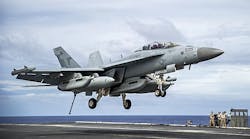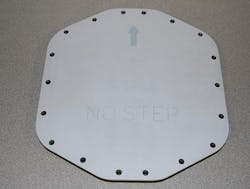Navy asks BAE Systems to build F/A-18 aircraft antennas that cut through enemy GPS jamming
PATUXENT RIVER NAS, Md. – U.S. Navy avionics experts are asking RF and microwave systems designers at BAE Systems Inc. to provide special anti-jam conformal aircraft antennas to ensure that F/A-18 combat jet pilots have continual access to Global Positioning System (GPS) satellite navigation signals even in the presence of electronic warfare (EW) jamming and interference.
Officials of the Naval Air Warfare Center Aircraft Division at Patuxent River Naval Air Station, Md., announced a $12.3 million contract Monday to the BAE Systems Electronic Systems segment in Greenlawn, N.Y., to build as many as 265 conformal-controlled reception pattern antenna (C-CRPA) units for different versions of the Navy's F/A-18 carrier-based combat jet.
The flat C-CRPA antennas fit closely against the fuselage of the F/A-18 aircraft to prevent undue aerodynamic drag and addition to the plane's radar cross section. The antenna is specially designed for the Navy's F/A-18E/F Super Hornet jet fighter-bomber and EA-18G Growler electronic warfare aircraft.
The BAE Systems C-CRPA is a seven-element anti-jam controlled reception pattern antenna that works together with the F/A-18's advanced digital antenna production (ADAP) digital antenna electronics (AE) to ensure reception of GPS signals amid EW jamming and interference. This antenna measures 14.1 by 14.1 inches, is 2.3 inches high, and weighs 4.5 pounds.
Related: GPS jamming is a growing threat to satellite navigation, positioning, and precision timing
This antenna project is part of the Navy's Air Navigation Warfare (NAVWAR) program, sponsored by the Navy Communications and GPS Navigation Program Office (PMW/A-170) at Patuxent River NAS, Md. The NAVWAR program provides GPS protection for Navy aircraft by giving the warfighter continued access to GPS through the use of anti-jam antenna systems like the BAE Systems C-CRPA that are designed to counter GPS EW threats due to intentional and unintentional interference.
Installations on Navy F/A-18s replace the aircraft's existing GPS antenna with a larger NAVWAR antenna and separate antenna electronics, while leaving the plane's GPS receiver in place. Future designs may combine the NAVWAR antenna and antenna electronics into one unit, Navy officials say.
The C-CRPA precision antenna array and companion electronics provides adaptive null steering in the presence of interfering signals for the F/A-18E/F and EA-18G aircraft. The antenna receives right-hand circularly polarized radiated signals at GPS L1 and GPS L2 frequencies from NAVSTAR GPS satellites.
Related: RF technology to keep military communications open amid EW jamming introduced by Exelis
Not only is the C-CRPA conformal to the F/A-18E/F and EA-18G aircraft, but it also and also incorporates unique operational requirements of low radar observability, Navy officials say. BAE Systems will build C-CRPA antennas at a rate of 53 antennas per year to meet expected aircraft retrofit schedules.
This contract to BAE Systems is a follow-on to a previous BAE Systems contract to produce the C-CRPA, which expired in July 2016. The Navy is contracting with BAE Systems sole-source. On this contract BAE Systems will do the work in Greenlawn, N.Y., and should be finished by June 2022. The deal is structured as a one-year contract with four one-year option periods.
For more information contact BAE Systems Electronic Systems online at www.baesystems.com, or the Naval Air Warfare Center Aircraft Division at www.navair.navy.mil/nawcad.
Learn more: search the Aerospace & Defense Buyer's Guide for companies, new products, press releases, and videos


